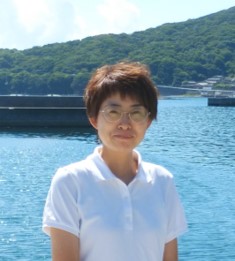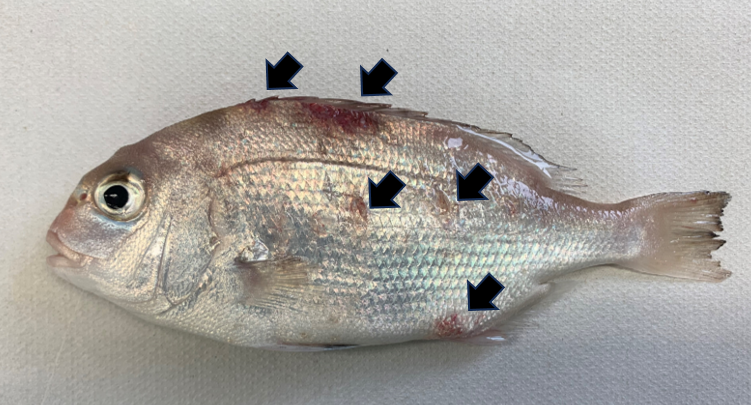Early detection and prediction of red tide and fish diseases for sustainable aquaculture production
※The content is current at the time of writing.
Predicting red tide and fish disease outbreaks from environmental DNA
Research Overview
Ehime Prefecture is a major producer of marine aquaculture, ranking first in Japan in the production of fish, as well as in the production of mother-of-pearl shells and cultured pearls. In particular, the coast of the Nanyo region, located in the southwestern part of Ehime Prefecture, is an ideal environment for aquaculture because the waves are calm due to the intricate rias coastline, and the seawater is purified several times a year by the dynamic tidal current called “Kyukishio,” which originates from the Kuroshio Current. However, sudden outbreaks of red tide and chronic fish diseases (fish diseases) cause mass mortality and quality deterioration of farmed fish and shellfish, and it is estimated that the Uwakai Sea alone causes several hundred million to several billion yen in fishery damage annually.
Red tide is a phenomenon in which plankton, especially phytoplankton, proliferate in seawater, causing the water to become colored. The proliferation of a type of plankton called toxic red tide plankton causes damage to the gills of cultured fish and shellfish, leading to their weakening and death. Conventionally, when seawater coloration is observed at an aquaculture site, it is brought to a local government laboratory, where it is observed under a microscope and the harmful species is determined. However, by that time, the red tide area has often already expanded into the fishing grounds, and the response to the red tide is often delayed, leading to major damage. In the case of fish diseases, fish that die at fish farms are subjected to pathological tests at laboratories, and countermeasures are taken according to the type of causative pathogens and other factors. However, in many cases, the disease has already spread within the fishing grounds by that time, leading to mass mortality, prolonged mortality, and quality deterioration.
Such red tides and fish diseases may seem to occur suddenly if one focuses only on the color of the seawater and the appearance of the cultured fish and shellfish. In reality, however, harmful red tide plankton and pathogens gradually increase from low concentrations in the seawater, and then become visible to the naked eye as a red tide or as the symptoms become apparent. Therefore, if the proliferation of harmful plankton and pathogens can be detected at an early stage before they become apparent, producers will be able to take countermeasures against red tide and fish diseases before or immediately after the outbreak, leading to a significant reduction in damage to the fishing industry. Therefore, our research group has established a gene detection technology for harmful red tide plankton and fish disease pathogens, and developed a highly sensitive early detection system for red tide and fish disease that monitors these harmful microorganisms in aquaculture waters.
Research Features
Microscopic examination of toxic plankton requires a cell density of at least 1 cell per mL for detection, and requires skilled techniques to distinguish toxic species from a variety of similar plankton species. Pathogens are also very small organisms, making detection by optical microscopy difficult. Although it is difficult to detect microorganisms in seawater with a microscope, it is known that seawater contains DNA of various organisms living in the water, so-called “environmental DNA,” which has recently been used to understand the biota in the aquatic environment and to quantify the amount of organisms. The main feature of this research is that it focuses on this “environmental DNA” and uses genetic analysis technology to detect harmful microorganisms contained in the “environmental DNA” in aquaculture waters at very low concentrations before red tide or fish diseases become apparent, leading to early detection and prediction of their occurrence. In particular, monitoring of red tide plankton in the Uwakai Sea area has shown that the gene levels of harmful plankton such as Karenia mikimotoi and Coccolodinium polychrysoides increase even before a red tide appears, indicating that this method is effective for early detection and prediction of red tides. This is effective for early detection and prediction of red tide.
A further major objective of this research is to promptly disseminate information to producers through an information dissemination system. Currently, information on early detection of red tide is provided to producers using the ” Ainan Town Water Area Information Portal ” operated by Ainan Town. In addition, the ” You see U-sea,” an information service on sea conditions in the Uwakai Sea established jointly with Ehime Prefecture, the Center for Coastal Environmental Sciences and the Graduate School of Science and Engineering at Ehime University, is widely disseminating red tide information along with real-time water temperature information in the Uwakai Sea, and is working to link this to early countermeasures.

Research Attraction
Phytoplankton and pathogens are very small microorganisms that cannot be seen with the naked eye, but one of the attractive features of our research is that we can detect their dynamic movements in the marine environment. The Nanyo Fisheries Research Center, where we conduct our research, is located in Ainan Town, Ehime Prefecture, where the fishing industry is thriving, and because it is so close to the fishing grounds, we are able to conduct our research in close cooperation with local producers, fishing cooperatives, prefectural and town governments, and research institutions both inside and outside the university. In fact, this research was initiated in response to requests from local producers for research and development of countermeasures against red tide and fish diseases, and is being conducted with the cooperation of local residents, including periodic water sampling for monitoring purposes. The great appeal of this research is that we can directly listen to the opinions of local fishery operators and cooperate with them to advance our research and lead it to practical application.
Future Outlook
So far, monitoring of harmful red tide plankton using genetic information has enabled early detection of red tide even before it occurs. In the future, we would like to verify this information with changes in environmental conditions surrounding plankton and cultured fish, such as water temperature, ocean currents, and weather conditions obtained from the ” Ainan Town Water Area Information Portal ” and ” You see U-sea,” to build a highly accurate red tide and fish disease outbreak prediction system. Furthermore, based on this early detection and forecasting system, we would like to develop a red tide control agent for early response. In addition to monitoring pathogen genes, we are also conducting research on predicting fish disease outbreaks based on changes in the physiological state of fish and various environmental DNA, etc. We hope to conduct research that will contribute to sustainable and stable aquaculture.
Message to those who are interested in this research
The term “fisheries science” may conjure up images of a discipline that studies only the fish and shellfish that end up on our dinner tables. In reality, however, the maintenance of the environment and risk management for the production and raising of fish and shellfish are also important issues for aquaculture production. Let’s think about the marine environment together at the Nanyo Fisheries Research Center, where you can be surrounded by the sea and experience the fishing industry firsthand!






